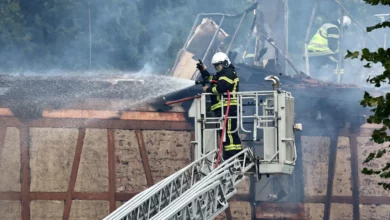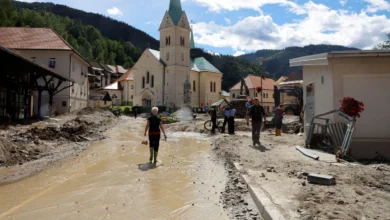
But questions remain about what exactly happened to the ill-fated vessel, whether recovery of the bodies or the submersible is possible, and what consequences the disaster may have for Oceangate, the company running the excursion to see the Titanic off the coast of Canada.
Here’s what you need to know about next steps for the Titan and the investigation into what happened.
What comes next in the search?
The multinational rescue effort has now turned into a recovery mission, with a remotely-operated vehicle scouring the ocean floor for debris from the deadly implosion.
Only one remotely-operated vehicle has made it to the immense depths where the Titanic wreck and the debris field from the sub lie: the Odysseus 6, operated by Pelagic Research Services. The Odysseus 6 discovered debris from the Titan submersible about 1,600 feet from the wreckage of the Titanic on Thursday, according to the US Coast Guard. The debris was consistent with the disastrous loss of the 22-foot-long vessel’s pressure chamber, the Coast Guard said. The loss would have resulted in an almost instantaneous inward collapse of the vessel, which was under immense pressure in the ocean depths.
The remotely operated vehicle found a total of “five different major pieces of debris” from the Titan, according to Paul Hankins, the US Navy’s director of salvage operations and ocean engineering. Officials located the submersible’s nose cone and one end of its pressure hulls in a large debris field. The other end of the pressure hull was found in a second, smaller debris field. Officials are working to map out the debris field.
“What they would do now is go back to that site and, like cookie crumbs, try to find a trail as to where that would lead,” said Tom Maddox, CEO of Underwater Forensic Investigators, who took part in a Titanic expedition in 2005.
He added the debris pieces could still be “slightly buoyant” and might be carried further away by ocean currents. “So the big project right now is going to be trying to collect those parts,” he said. “They’ll mark them, they’ll indicate where they were, and they’ll lay out a map of where those parts were found.”
The Odysseus 6 began a second mission to the site on Friday, according to Pelagic Research Services. A spokesperson for the company told CNN the vehicle will continue to search for debris and map out the debris sites. The debris from the sub is likely too heavy for Pelagic’s ROV to lift by itself, so any recovery mission will be made alongside Deep Energy, another company assisting with the mission, which will use rigged cabling to pull up any pieces of the destroyed vessel.
The crew of search and rescue vessels that gathered in the Atlantic are beginning to dissipate. The Navy is removing a deep ocean salvage system that arrived in St. John’s on Wednesday, a defense official told CNN on Friday. And the Polar Prince, the Titan’s support ship, departed the area of the Titanic wreckage on Friday.
Can the bodies of the passengers be recovered?
Five passengers were aboard the Titan when it imploded: Pakastani businessman and his son, Shahzada and Suleman Dawood; British businessman Hamish Harding; French diver Paul-Henri Nargeolet; and Stockton Rush, the pilot of the vessel and CEO of the vessel’s operator, OceanGate Expeditions.
All five are presumed dead after the “catastrophic implosion” of the submersible, according to the US Coast Guard. But it’s unclear whether any remains will be able to be recovered.
On Friday, Coast Guard Rear Adm. John Mauger said, “I don’t have an answer for prospects at this time” when asked about recovering remains. He noted the “incredibly unforgiving environment” in the depths of the ocean near the Titanic wreck and the intense pressure that far down.
A medical expert said that the implosion would likely leave no recoverable remains.
“There would be virtually nothing,” Aileen Marty, a disaster medicine expert at Florida International University, told CNN’s Anderson Cooper. “They’re very unlikely to find anything there of human tissue.”
Tributes to the five victims came pouring in after the Coast Guard announced they were presumed dead. All five shared “shared a distinct spirit of adventure,” OceanGate said in a statement.
When did the Titan implode?
It’s unclear when or where exactly the submersible imploded. Mauger said Thursday that it will take time to establish a specific timeline of events in the “incredibly complex” disaster.
The expedition set out from Newfoundland, Canada, on June 16 on the Polar Prince, the Titan’s support ship. The ship took participants to the site of the Titanic wreck, about 350 miles off Newfoundland’s coast. On Sunday, June 18, the five passengers began their descent to the Titanic in the submersible, launched from the support ship, which remained on the surface.
They began the dive around 9 a.m. and were expected to resurface at 6:10 p.m., according to Miawpukek Maritime Horizon Services, which co-owns the Polar Prince. But the group last communicated with the surface at 11:47 a.m. Authorities were notified at 6:35 p.m. and rescue operations began, according to Maritime Horizon.
The Navy detected a sound that was “consistent” with an implosion on Sunday, but it was determined to be “not definitive.” Authorities searched for the submersible in the hope that the vessel might still be intact and its occupants alive.
On Tuesday, authorities detected “banging noises” underwater, sparking hope that the submersible, which was equipped with 96 hours of oxygen, might still be intact and its passengers alive.
But by Thursday afternoon, authorities determined the sub had imploded and said there did not seem to be a connection between the noises and the debris.
Who will investigate the incident?
Authorities in both the US and Canada announced probes of the incident.
The US Coast Guard and the Transportation Safety Board of Canada announced the launch of investigations Friday, though it’s unclear whether the agencies are conducting separate examinations or working together for one.
“The Transportation Safety Board of Canada (TSB) is launching an investigation into the fatal occurrence involving the Canadian-flagged vessel Polar Prince and the privately operated submersible Titan,” the agency announced in a statement.
The agency is traveling a team to St. John’s and Labrador to conduct the probe.
The US Coast Guard also would investigate the incident, according to a post on Twitter by the National Transportation Safety Board.
A Coast Guard official said Thursday that authorities are discussing how an investigation would unfold since the implosion took place in international waters. Experts have suggested that that any probe would consider the submersible’s design, the materials used to build it, and Rush and OceanGate’s role in the deathly disaster.
What’s next for OceanGate?
The disaster has cast scrutiny on OceanGate, the Titan’s operator. The company, which sold its trips to the Titanic for $250,000 per passenger, is no stranger to criticism. In the past years, at least two OceanGate employees voiced concerns about the submersible’s carbon fiber hull. One employee, OceanGate’s former director of marine operations David Lochridge, claimed in a court filing that he was wrongfully terminated in 2018 for raising concerns about the Titan’s safety and testing. The case was settled out of court.
And William Kohnen, chair of the Marine Technology Society’s manned underwater vehicles committee, told CNN Friday that he had raised his own concerns with CEO Rush and said that the vessel’s unique carbon fiber hull warranted “special extra attention.” He said a community of submersible experts had issued a letter to Rush suggesting he might be moving too quickly and ignoring safety regulations.
It is unclear if OceanGate will continue its operations after the catastrophe. In a statement about the deaths, the company said, “This is an extremely sad time for our dedicated employees who are exhausted and grieving deeply over this loss.”
OceanGate faced a series of mechanical problems and inclement weather conditions that forced the cancellation or delays of trips in recent years, according to court records.
In a 2019 blog post, the company defended its choice not to have its vessel “classed” or certified by any safety organizations. The blog said most marine operations “require that chartered vessels are ‘classed’ by an independent group such as the American Bureau of Shipping (ABS), DNV/GL, Lloyd’s Register, or one of the many others.”
But the Titan is not classed by any independent group, according to the blog post, in part because classing innovative designs often requires a multi-year approval process, which interferes with rapid innovation. Additionally, “classing is not sufficient to ensure safety” by itself, the company’s blog post said.
Additionally, the vessel operated in international waters, allowing it to skirt national regulations.
Rush, the company’s founder and CEO and one of the passengers who died in the implosion, previously made comments about breaking rules in pursuit of innovation.
“At some point, safety just is pure waste,” Rush told journalist David Pogue in an interview last year. “I mean, if you just want to be safe, don’t get out of bed. Don’t get in your car. Don’t do anything.”
CNN’s Jessie Yeung, Celina Tebor, and Paul P. Murphy contributed to this report.




